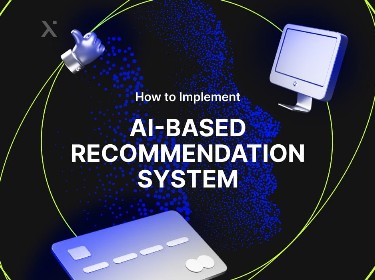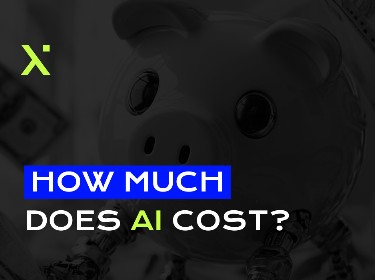Artificial intelligence can enable businesses to excel and prosper. However, this is achievable only if organizations invest time and effort in developing a robust AI strategy before integrating the technology into their workflows.
With the global AI market size projected to reach a value of $1,847.58 billion by 2030, it is crystal clear that AI is a pivotal tool for future business operations.
Yet, achieving tangible results goes beyond merely adopting AI: it requires a carefully crafted roadmap.
A well-thought-out and thorough AI strategy is the backbone of successful AI integration, empowering businesses to stay relevant and thrive in this dynamic landscape.
Read on to discover why businesses need an AI strategy and explore the essential steps you need to follow when developing your own AI business strategy.
What is an AI strategy?
An AI strategy is a holistic plan and roadmap that details how a business aims to harness artificial intelligence to achieve its specific goals and objectives.
Such a strategy touches upon a range of elements, from assessing the organization’s existing data infrastructure and capabilities to setting clear objectives, allocating the necessary resources, and deploying particular AI-driven solutions.
Importantly, a comprehensive enterprise AI strategy should tackle the ethical implications, pinpoint potential risks alongside their mitigation strategies, and chart out plans for training employees to incorporate this new technology into their daily workflows.
Discover the world of generative AI. Dive into our blog for a complete guide on its history, stats, and trends
Why do businesses need an AI strategy?
![]()
A thoughtfully constructed AI strategy not only underscores foundational principles but also offers numerous benefits, including streamlined resource allocation, enhanced risk management, ethical AI deployment, and seamless integration with existing systems.
Streamlined resource allocation
By designing and adopting a detailed AI strategy, businesses can ensure their investments are directly aligned with core objectives. This drives optimal ROI and prevents wasteful spending on non-strategic initiatives.
Enhanced risk management
Despite its many transformative capabilities, AI is not without complexities, which can range from data security challenges to ethical dilemmas. A comprehensive AI strategy, however, equips businesses to proactively address and navigate these challenges, ensuring a safer and more responsible implementation.
Ethical AI deployment
With a well-defined AI strategy, businesses can set forth concrete guidelines that uphold transparency. This addresses critical concerns like bias and data privacy, thereby fostering trust among stakeholders and users.
Smooth integration with existing systems
An AI strategy offers a structured roadmap for seamlessly integrating AI technologies into current workflows. This not only prepares employees for the smooth transition but also optimizes operational processes.
Explore essential insights on AI and privacy: uncover key business concerns and discover effective solutions
10 important steps to follow when building an AI strategy for your business
![]()
Crafting an AI strategy can be intricate, as businesses must navigate multiple details without deviating from their fundamental objectives.
Below, we present a 10-step guide to formulating an effective AI business strategy, highlighting crucial facets to consider.
Step 1. Evaluate how AI can enhance your workflows
First and foremost, your AI strategy should include a detailed overview of your business’s current state. This implies that you will need to examine your data infrastructure, technology capabilities, and staff expertise, as well as identify processes ripe for AI enhancements and pinpoint potential inefficiencies or vulnerabilities.
With this foundational understanding, you can further analyze how AI can specifically benefit your business workflows. Map out your existing processes to determine where automation, data analytics solutions, or other AI capabilities could introduce efficiencies or innovations.
To simplify, consider asking yourself the following questions:
- Which tasks are repetitive and could be automated?
- Where are the bottlenecks in our current processes?
- Could predictive analytics improve our decision making in certain areas?
Focusing on these workflow-centric questions, you will be able to ensure that your AI investments lead to tangible improvements.
Step 2. Establish clear goals and objectives
When formulating your AI business strategy, you need to set precise and well-defined goals. Identify what your organization aims to accomplish with AI, whether it is enhancing customer experience, streamlining operational processes, or predicting market trends. Doing so ensures your AI endeavors align perfectly with these targets.
Always make sure your goals adhere to the SMART (Specific, Measurable, Achievable, Relevant, and Time-bound) principle. This approach not only provides clear direction but also simplifies performance assessment.
As you establish these AI objectives, integrate them into your broader business vision. This ensures that your goals address immediate requirements while also adding long-term strategic value.
To further optimize and refine your approach, consider collaborating with AI and machine learning consulting experts. They can provide comprehensive insights and best practices to ensure the success of your AI initiatives.
Unlock the full potential of your business with expert IT consulting. Reach out to us today and pave the way for transformative solutions and enhanced growth
Step 3. Foresee and embed security measures
When working out your AI implementation strategy, always put security first.
Businesses should have a clear plan that dictates how they will keep data safe at all stages. This means having strong controls over who can access data and making sure AI models can stand up against any attacks.
It is also a good idea to do regular security checks and have a plan ready for any safety problems that might come up. Furthermore, remaining abreast of the latest security threats and best practices is crucial.
Step 4. Prioritize ethical deployment and regulatory adherence
As AI becomes increasingly integral to decision-making processes, it is really important to maintain a commitment to both ethical guidelines and regulatory compliance.
Your AI strategy framework should emphasize transparency, ensuring that your stakeholders and users have a clear picture of how AI-driven decisions are made. It is equally important to recognize the broader effects of AI on society, which is why you may consider conducting regular assessments of the ethical aspects of your AI, with insights from outside experts, including AI strategy consulting companies.
At the same time, navigate the ever-evolving regulatory landscapes associated with AI. Understand the intricacies of data privacy laws, industry-specific AI standards, and upcoming legal changes.
By aligning your AI deployment strategy with ethical best practices and regulatory frameworks, you will not only boost stakeholder trust but also underscore your company’s dedication to responsible AI use.
Dive into the global landscape of artificial intelligence regulation and explore the diverse laws and policies that countries apply to this transformative technology
Step 5. Strategize data collection and processing
The efficacy of AI models largely depends on the quality and quantity of the data they are trained on.
In your AI strategy framework, develop a comprehensive plan for data collection and processing. Identify your data sources to ensure diversity, and relevance, and evaluate the scalability of your data pipelines. Additionally, consider how to manage potential data biases and ensure robustness in your models.
Step 6. Integrate AI literacy into organizational development
As AI technologies become integral to business operations, ensuring that the workforce is well-versed in them is essential.
To this end, your AI implementation strategy should encompass a robust framework for continuous learning, addressing both foundational AI concepts and role-specific applications. Besides, collaborating with training partners and AI strategy consulting firms can offer structured learning pathways.
Overall, by fostering a culture where employees are encouraged to keep pace with AI advancements, organizations remain agile and forward-looking.
Discover the 7 pivotal digital transformation challenges and master our expert tips to battle them
Step 7. Catalog AI tools and technologies for deployment
In your AI strategy, you need to specify the platforms, frameworks, and software your organization intends to use for AI deployment. This could include machine learning platforms like TensorFlow or PyTorch, data processing tools like Apache Kafka or Hadoop, and specialized solutions for tasks such as natural language processing or computer vision.
Also, consider outlining the criteria used for selecting these tools such as scalability, community support, or integration capabilities. A well-curated list ensures that stakeholders are informed and that the organization leverages the best tools for its specific needs, paving the way for effective and streamlined AI implementations.
Master the future: explore the three essential machine learning techniques for your business success
Step 8. Set benchmarks for AI performance metrics
To guarantee AI deployments align with your business goals, you will need to set clear performance benchmarks in your AI implementation strategy.
Highlight the primary metrics that determine AI’s effectiveness for different tasks like accuracy for categorization, latency for instantaneous systems, or precision and recall for search operations.
Plus, regularly review and adjust these benchmarks, taking into account actual outcomes and evolving business needs.
Through setting transparent performance criteria, you will be able to uphold a consistent standard for AI quality and make educated choices about model adjustments and further deployment.
Step 9. Strategically allocate and optimize your resources
To successfully execute AI deployment, your AI business strategy needs to cover the allocation of resources — from personnel and budget to infrastructure.
This implies that you will have to take care of the following aspects:
- Determine necessary skill sets: Recognize the expertise needed. This might involve hiring new specialists, training current staff, or partnering with external AI strategy consulting experts.
- Evaluate infrastructure demands: Ensure that both hardware and software are up to par for your AI projects. This could mean investing in high-performance computing clusters or tapping into cloud services.
- Allocate the budget wisely. Anticipate the financial requirements of your AI endeavors. Develop a detailed budget that accounts for technology, talent acquisition, and unforeseen challenges. Always set aside a contingency fund for unexpected expenses and factor in funds for continuous learning and upgradation.
See how PixelPlex AI developers engineered this retail platform for better customer shopping experience
Step 10. Design for flexibility and adaptability
The AI landscape is dynamic and characterized by rapid advancements and shifting paradigms.
As such, your AI strategy framework should be crafted with inherent flexibility, allowing for adjustments and pivots as needed.
Establish regular review points to assess the strategy’s effectiveness in light of recent technological advancements, market changes, and internal business shifts. Also, encourage feedback from all stakeholders to identify areas for improvement.
By doing this, you will ensure that your AI strategy remains relevant, resilient, and primed to capitalize on emerging opportunities, even in a rapidly evolving ecosystem.
Closing thoughts
Embarking on an AI journey demands proactive vision, meticulous preparation, and continuous evolution. It is within this framework that developing a comprehensive AI strategy, as outlined in this guide, becomes pivotal to harnessing the full potential of AI.
The roadmap to AI success does not have to be traversed alone.
We at PixelPlex understand the nuances and complexities of AI integration and deployment as well as AI strategy consulting. We have dedicated ourselves to offering custom AI development services that align with your unique business objectives, ensuring you harness the full potential of AI innovations. Our services include:
- AI models development
- ML development
- Business intelligence services
- Data analytics
- Predictive analytics
As you contemplate the future of your enterprise in the realm of AI, let our expertise be the catalyst that propels you forward. Together, we can co-create solutions that redefine the boundaries of what’s possible.




